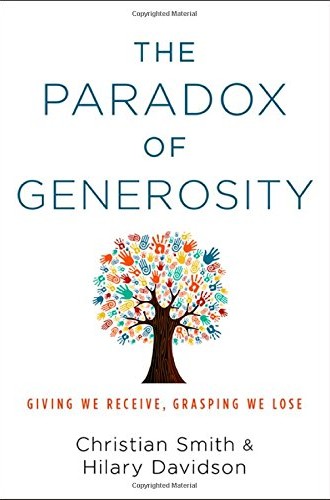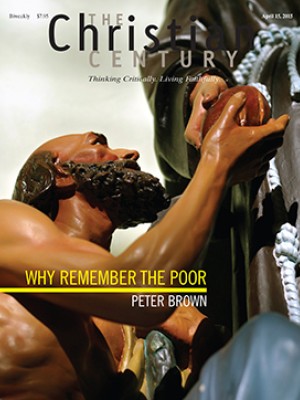The Paradox of Generosity, by Christian Smith and Hilary Davidson
The Paradox of Generosity is a tale of two ways of life. Bryan, whom we meet in the book, admits that he is “not Mother Teresa.” At Christmas he prefers to give himself an extra gift rather than making a charitable donation. With his life wrapped up in his own needs, he finds himself overbusy, cranky, anxious, lonely, and prone to overindulging in alcohol. In the same household, his wife, Shannon, enjoys giving to others, especially at holidays like Christmas, and she volunteers as a soccer coach. She has a strong network of friends and has seen improvements in her mental and physical health as she overcomes an eating disorder.
Apparently Jesus was correct when he said that it is more blessed to give than to receive. My mother will be relieved to hear me say that. She was fond of quoting Jesus when my juvenile self-centeredness reared its head too determinedly. Some of us, according to Christian Smith and Hilary Davidson, took our mothers’ admonitions to heart and grew into adults blessed with a spirit of generosity that is demonstrated in our actions. As a result, we enjoy better health, more happiness, and a greater sense of purpose and satisfaction in our lives. Most of us, however, seem to have ignored our mothers and have developed into people focused primarily on acquiring things and holding on to them, seldom sharing ourselves or our possessions with others. Associated with this grasping posture are poorer health, less happiness, and a loss of meaning and sense of purpose for our lives.
Read our latest issue or browse back issues.
Smith and Davidson document this connection in great detail. Paradoxically, despite the positive consequences of generosity, few Americans are generous people. By almost any measure of generosity, the majority of Americans are crowded at the ungenerous end of the scale. For example, the authors’ survey indicates that only 2.7 percent of Americans give away 10 percent or more of their income, while 86.2 percent give less than 2 percent. This pattern persists, sometimes to a lesser degree, across all forms of generosity.
Smith is a professor of sociology at the University of Notre Dame, where he directs the Science of Generosity Initiative, a large and ongoing research endeavor. Davidson is a doctoral student and a researcher on the project, a large-scale, multimethod study of American practices of generosity and respondents’ well-being. The data were collected in a large national survey, a somewhat smaller survey of congregations in three midsize midwestern cities, and in-depth interviews in 40 households across the United States. The measures of generosity include financial giving, volunteering, relational generosity to those close by, blood and organ donation, and estate planning; the measures of well-being include happiness, bodily health, purpose in living, avoidance of depression, and interest in personal growth. Smith and Davidson show repeatedly that there is a consistent positive (though sometimes modest) correlation between generosity and well-being. The more generous one is, the better off one is.
Smith and Davidson do address the potential criticism that correlation is not causation—that is, the fact that generosity and a high level of well-being often occur together doesn’t necessarily mean that generosity produces the giver’s well-being. It could be the other way around. However, they suggest nine ways in which generosity could cause the giver’s well-being. For example, generosity fosters and reinforces positive emotions that contribute to health and well-being, and it can trigger chemical systems in the brain that heighten pleasure, reduce stress, and suppress pain. Their causal arguments are largely drawn from others’ research rather than their own data, which cannot demonstrate causal linkages because they are taken from a single point in time. They argue that the relationship between generosity and well-being is best understood as reciprocal and mutually reinforcing.
In the final two substantive chapters, Smith and Davidson take an intimate look into the lives of ungenerous and generous Americans. Thanks to their in-depth interviews and visits in the homes of their subjects, Smith and Davidson are able to give us a nuanced picture of how individuals and families talk about generosity, explaining and justifying their choices about whether to share their time and possessions. Readers will get to know these representative households well, and in so doing they will be faced with questions about and gain insight into their own practices of generosity or miserliness.
Smith and Davidson took on a difficult task in addressing both a social science audience and a broader readership interested in generosity as a value or practice. It is not easy to satisfy both an expert and a general audience at once, though social scientists often try to do so. In this case, I expect that both audiences will be partially satisfied and partially unsatisfied by the authors’ presentation and analysis.
Social scientists will no doubt be frustrated by the dearth of explanation for the patterns Smith and Davidson describe. They will be pleased, however, with the detailed descriptions and will likely be convinced that the relationship between generosity and well-being is a social fact. The book is likely to be cited frequently and to spark additional research testing potential explanations for the observed patterns.
The general audience is likely to balk at the number of tables and repeated discussions of the many bivariate correlations, even though the authors relegate most of the methodological technicalities to the footnotes and appendices. On the other hand, the interview-based chapters focusing on the real lives of generous and ungenerous people will spark many a helpful discussion.
For me, the most frustrating unanswered question is related to the paradox the authors mention in their introduction. If givers receive and graspers lose, why does such a large majority of Americans nonetheless choose to be ungenerous? In their concluding chapter, the authors exhort readers to consider the positive consequences of generosity and to become more generous themselves. But without an adequate explanation for how broad patterns of ungenerosity emerge in the first place, it will be hard for churches or policy makers to know how to improve Americans’ generosity quotient beyond exhorting them to embody individual virtue. Smith and Davidson leave plenty for all of us to work on, churches and social scientists alike. They also give us a keen sense of the baseline from which we begin.







